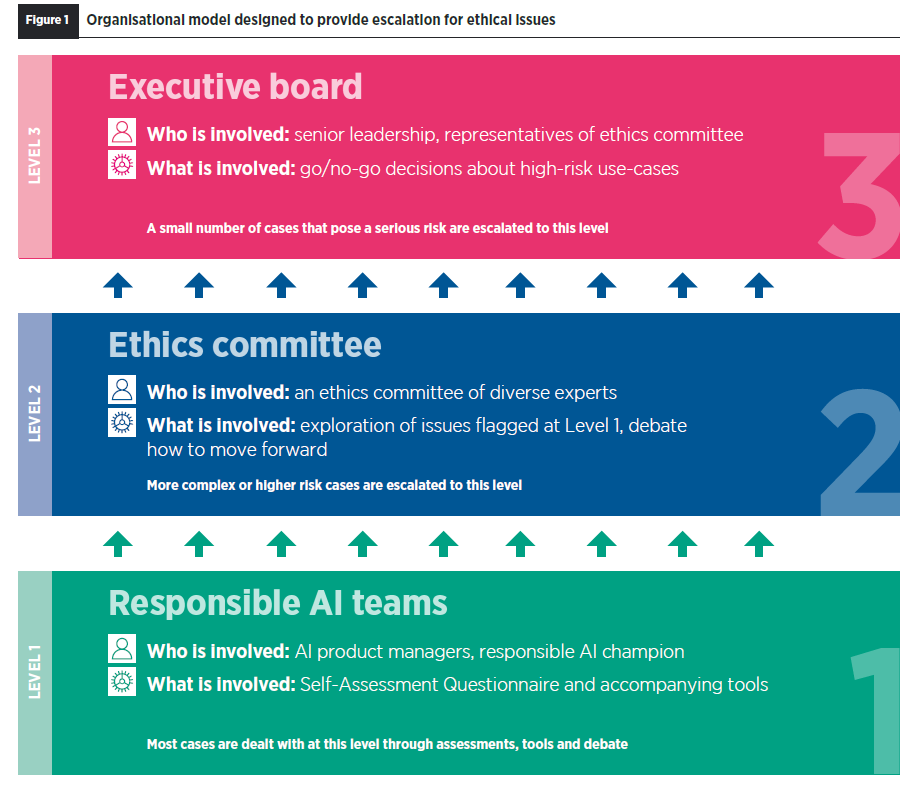The previous blog of this series provided an introduction to the value of artificial intelligence (AI) and explained the importance of ethical AI. This blog will look at a key consideration when implementing AI into everyday business activities – the governance model.
What is AI governance?
AI governance refers to how systems use algorithms to draw inferences and make decisions, requiring policies governing their design, development, and deployment. These policies should be based on ethical principles. Creating policies and ensuring they are followed throughout an organisation requires a robust governance structure with clear roles and responsibilities.
This blog describes one example of a governance model -, further examples can be found in The AI Ethics Playbook, Chapter 2. It also provides an exercise, designed to help organisations with some important considerations for deciding on an appropriate governance model.
Governance Model Example: designed for escalation of ethical issues
This model is designed for flexibility. It involves a structure of decision-making and reporting, to help embed accountability for AI systems within an organisational culture. It improves agility by removing bottlenecks. It is important to add that this governance model will require investment in people, tools and policies to be successful.
The proposed governance structure has three levels. These levels indicate the process for escalating higher risk or more complex use cases.

At Level 1, the people closest to an AI system, often the AI Product Managers, use a Self-Assessment Questionnaire and accompanying tools to understand the ethical implications of a particular use case in line with the principles.
Many companies create a new role (eg Responsible AI (RAI) Champion) or a team dedicated to supporting thinking about ethical implications of AI systems, anticipating unintended consequences, and ensuring accountability for AI-related decisions and actions.
In the instance of higher risk or unknowns, the RAI Champion will escalate this to Level 2, where an ethics committee of experts drawn from different disciplines and geographies explores the issues raised. This ethics committee should include engineers, trained ethicists, sociologists, engineers, and legal and human rights experts.
While the responsibilities of the committee will differ between organisations, they might include:
- Studying concrete scenarios involving the ethical use of data and AI upon request
- Issuing prospective opinions on the use of data and AI technologies
- Drawing up ethics guidelines for the responsible use of data and AI
- Creating recommendations and policies
The ethics committee may decide the use of an AI system in a specific context presents unacceptable risks, or that an AI system has inherent limitations making it inappropriate for the intended purpose. The committee will then escalate this to a separate body with executive oversight. Level 3, therefore, represents an executive board who bear ultimate responsibility for deciding whether the development and deployment of an AI system should proceed. Escalation to this level would only happen on the rare occasions where an issue presents a high-level risk to people, society or the environment and, therefore, the reputation of the company.
Flexibility was the main reason to spotlight this governance model. However, and very importantly, by using the proposed model in the right way, an organisation can reduce bottlenecks, provide accountability, and strengthen understanding of everyone’s level of responsibility. It also clearly shows how to manage situations that cannot be resolved individually and escalates issues only when needed.
Creating an appropriate structure
Finally, an effective AI governance structure needs to consider organisational culture, size, strategy, and AI maturity. When deciding on an AI governance structure it is important to involve a diverse range of colleagues from within an organisation. Involving diverse, multidisciplinary stakeholders in the process of creating a governance structure will help bring a diversity of perspectives.
We invite you to download The AI Ethics Playbook, to read further information and resources on the governance model and required considerations. In addition, it provides multiple real-life examples from the mobile industry, including Orange, Telstra, and Telefonica.